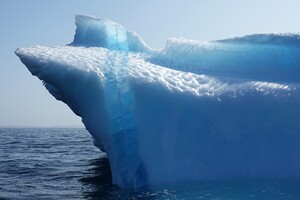Already by 2100, the sea level may rise by half a meter.

A group of researchers from Australia, France, Great Britain and the United States, led by scientists from Durham University, said that the melting of the largest ice sheet on Earth could raise sea levels “by several meters” over several centuries if the global temperature rises by two degrees Celsius. Science Alert. According to them, if greenhouse gas emissions remain at current levels, the melting of the East Antarctic Ice Sheet could lead to a rise in sea level by half a meter already by 2100.
Read also: Climate change makes infectious diseases more dangerous – scientists
If greenhouse gas emissions remain high after that, melting ice sheets could raise sea levels by one to three meters by 2300 and five meters by 2500. But if we do manage to reduce emissions, the melting of this glacier will raise the sea level by only two centimeters by 2100.
“The key conclusion of our study is that the fate of the East Antarctic Ice Sheet is in our hands. So far, this is the largest ice sheet on the planet, if it completely melts, could raise sea levels by 52 meters, it is very important that we do not wake this sleeping monster,” said the lead author of the study Chris Stokes.
He also added that stopping the global temperature rise within two degrees Celsius above the pre-industrial level will help humanity avoid the worst-case scenario of climate change, and possibly stop the melting of the East Antarctic Ice Sheet.
The authors of the study also note that the worst-case scenario is “extremely unlikely.” They analyzed how the East Antarctic Ice Sheet responded to periods of warming that occurred in the past.
In addition, the researchers conducted computer simulations that showed the effects of different levels of greenhouse gas emissions on the glacier by 2100, 2300 and 2500 year.
It turned out that three million years ago, when the temperature on the planet was two to four degrees higher, part of the East Antarctic ice sheet “collapsed and added several meters to the global sea level”.
There is also evidence that as recently as 400,000 years ago, recently by geological standards, a part of the shield retreated 700 kilometers deep into the land in response to a warming of one or two degrees Celsius.
Related video
Remember, data from the European Copernicus satellite system have shown that the past seven years have been the hottest on record. Last year, 2021, became the fifth in the list of hottest years, temperature records were registered in some regions.
See special topic: Climate changes make infectious diseases more dangerous – scientists In the near future, it is necessary to closely monitor 277 known diseases. Climate change could destroy human civilization – scientists Researchers urge to prepare for the worst scenario of global warming. Abnormal temperatures have critically accelerated the melting of Greenland's glaciers The island lost six billion tons of water every day for a week. In the next 40 years, the heat will only intensify – WMO The temperature rises to abnormal values more and more often due to climate change. A “sand battery” was created in Finland that will help fight climate change According to the developers, the battery should solve the main problem of green energy.




